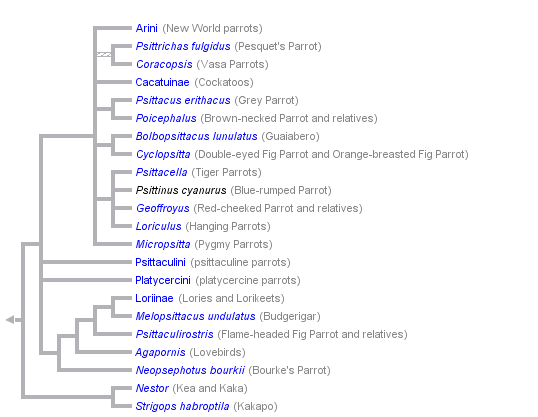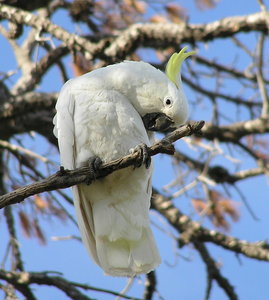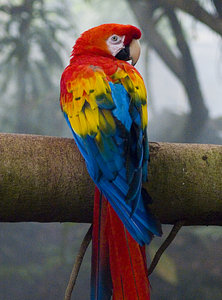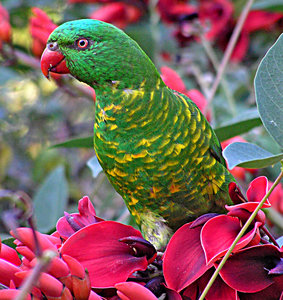Psittaciformes
Psittacidae
Parrots, Cockatoos, Lories, Lorikeets
John Harshman


This tree diagram shows the relationships between several groups of organisms.
The root of the current tree connects the organisms featured in this tree to their containing group and the rest of the Tree of Life. The basal branching point in the tree represents the ancestor of the other groups in the tree. This ancestor diversified over time into several descendent subgroups, which are represented as internal nodes and terminal taxa to the right.

You can click on the root to travel down the Tree of Life all the way to the root of all Life, and you can click on the names of descendent subgroups to travel up the Tree of Life all the way to individual species.
For more information on ToL tree formatting, please see Interpreting the Tree or Classification. To learn more about phylogenetic trees, please visit our Phylogenetic Biology pages.
close boxRelationships after de Kloet and de Kloet 2005.
References
Brightsmith, D. J. 2005. Competition, predation and nest niche shifts among tropical cavity nesters: phylogeny and natural history evolution of parrots (Psittaciformes) and trogons (Trogoniformes). Journal of Avian Biology 36:64-73.
Collar, N.J. 1997. Psittacidae (Parrots). Pages 280-477 in Handbook of the Birds of the World. J. del Hoyo, A. Elliott, and J. Sargatal, eds. BirdLife International and Lynx Editions, Cambridge, UK and Barcelona.
de Kloet, R. S. and S. R. de Kloet. 2005. The evolution of the spindlin gene in birds: Sequence analysis of an intron of the spindlin W and Z gene reveals four major divisions of the Psittaciformes. Molecular Phylogenetics and Evolution 36:706-721.
Forshaw, J. M. 2006. Parrots of the World. Princeton University Press.
Forshaw, J. and W. T. Cooper. 2002 Australian Parrots, 3rd edn. Robina Press, Queensland, Australia.
Higgins, P. J. 1999 Handbook of Australian, New Zealand and Antarctic birds, vol. 4: Parrots to Dollarbird. Oxford University Press, Melbourne, Australia.
Juniper, T. and M. Parr. 1998. Parrots: A Guide to Parrots of the World. Yale University Press, New Haven.
Miyaki, C. Y., S. R. Matioli, T. Burke, and A. Wajntal. 1998. Parrot evolution and paleogeographical events: mitochondrial DNA evidence. Molecular Biology and Evolution 15:544-551.
Wright, T. F., E. E. Schirtzinger, T. Matsumoto, J. R. Eberhard, G. R. Graves, J. J. Sanchez, S. Capelli, H. Muller, J. Scharpegge, G. K. Chambers, and R. C. Fleischer. 2008. A multilocus molecular phylogeny of the parrots (Psittaciformes): Support for a Gondwanan origin during the Cretaceous. Molecular Biology and Evolution 25(10):2141-2156; doi:10.1093/molbev/msn160.
Title Illustrations

| Location | Canberra, ACT, Australia |
|---|---|
| Specimen Condition | Live Specimen |
| Source | sulphur-crested cockatoo |
| Source Collection | Flickr |
| Image Use |
 This media file is licensed under the Creative Commons Attribution-NonCommercial License - Version 2.0. This media file is licensed under the Creative Commons Attribution-NonCommercial License - Version 2.0.
|
| Copyright | © 2006 Pierre Pouliquin |
| Location | captive at Sedgwick County Zoo |
|---|---|
| Specimen Condition | Live Specimen |
| Source | Scarlet Macaw (Ara macao) |
| Source Collection | Flickr |
| Image Use |
 This media file is licensed under the Creative Commons Attribution-NonCommercial-ShareAlike License - Version 2.0. This media file is licensed under the Creative Commons Attribution-NonCommercial-ShareAlike License - Version 2.0.
|
| Copyright | © 2006 Brent Danley |
| Scientific Name | Trichoglossus chlorolepidotus |
|---|---|
| Location | Kalinga Park, Brisbane, Queensland, Australia |
| Specimen Condition | Live Specimen |
| Source | 137 Scaly-breasted Lorikeet |
| Source Collection | Flickr |
| Image Use |
 This media file is licensed under the Creative Commons Attribution-NonCommercial-NoDerivs License - Version 2.0. This media file is licensed under the Creative Commons Attribution-NonCommercial-NoDerivs License - Version 2.0.
|
| Copyright | © 2006 Jenny |
About This Page
Correspondence regarding this page should be directed to John Harshman at
Page copyright © 2007
 Page: Tree of Life
Psittaciformes. Psittacidae. Parrots, Cockatoos, Lories, Lorikeets.
Authored by
John Harshman.
The TEXT of this page is licensed under the
Creative Commons Attribution-NonCommercial License - Version 3.0. Note that images and other media
featured on this page are each governed by their own license, and they may or may not be available
for reuse. Click on an image or a media link to access the media data window, which provides the
relevant licensing information. For the general terms and conditions of ToL material reuse and
redistribution, please see the Tree of Life Copyright
Policies.
Page: Tree of Life
Psittaciformes. Psittacidae. Parrots, Cockatoos, Lories, Lorikeets.
Authored by
John Harshman.
The TEXT of this page is licensed under the
Creative Commons Attribution-NonCommercial License - Version 3.0. Note that images and other media
featured on this page are each governed by their own license, and they may or may not be available
for reuse. Click on an image or a media link to access the media data window, which provides the
relevant licensing information. For the general terms and conditions of ToL material reuse and
redistribution, please see the Tree of Life Copyright
Policies.
- First online 14 December 2005
- Content changed 31 August 2007
Citing this page:
Harshman, John. 2007. Psittaciformes. Psittacidae. Parrots, Cockatoos, Lories, Lorikeets. Version 31 August 2007 (temporary). http://tolweb.org/Psittacidae/26406/2007.08.31 in The Tree of Life Web Project, http://tolweb.org/












 Go to quick links
Go to quick search
Go to navigation for this section of the ToL site
Go to detailed links for the ToL site
Go to quick links
Go to quick search
Go to navigation for this section of the ToL site
Go to detailed links for the ToL site